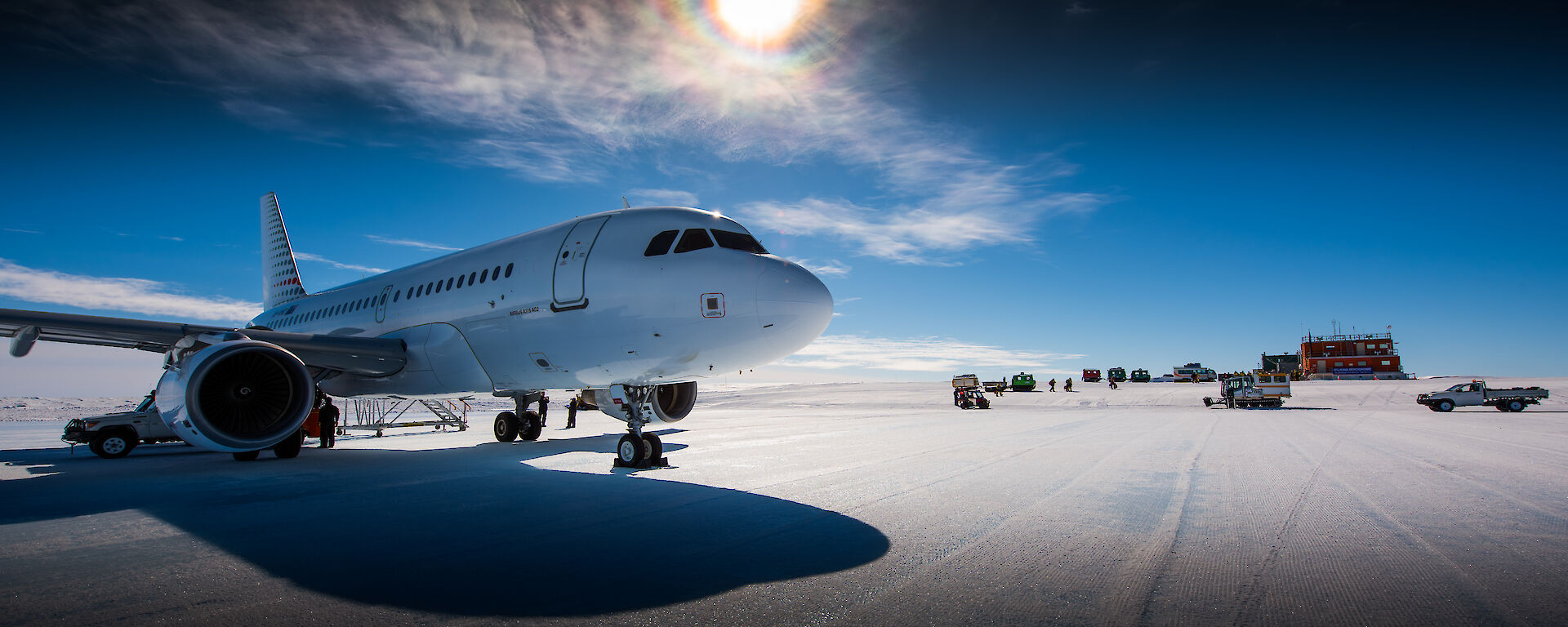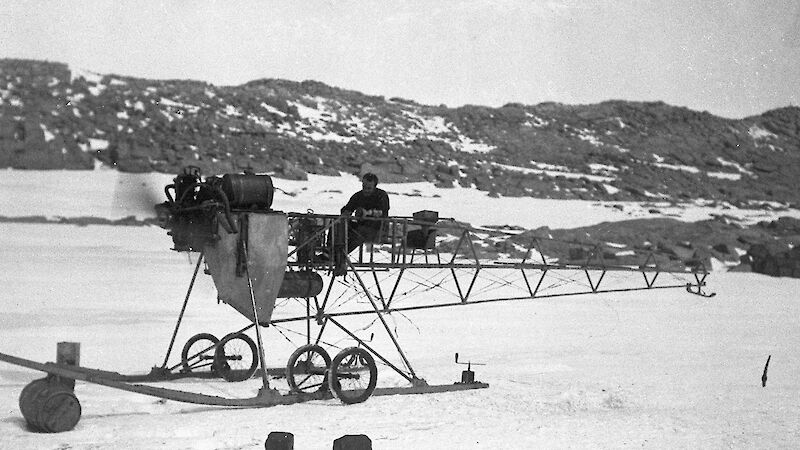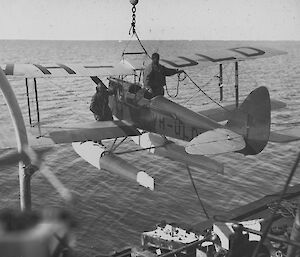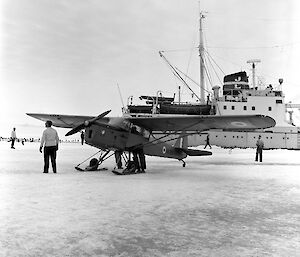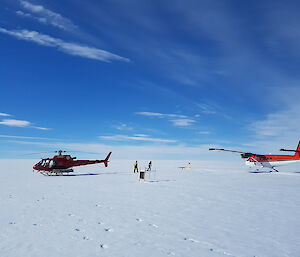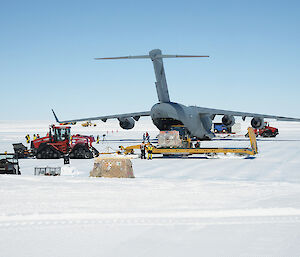Since the earliest days of Antarctic exploration, the vast distances and the difficulties of overland traverse have made the prospect of surveying the continent by air extremely appealing. Some of the earliest Antarctic experiments with airborne craft included Robert Falcon Scott’s ascent in a tethered hydrogen balloon in 1902, and Edgeworth David’s use of box kites to carry meteorological instruments aloft in 1907.
Australia’s Sir Douglas Mawson considered the potential of fixed-wing aviation for aerial surveying, as part of the Australasian Antarctic Expedition in 1911. A mere eight years after the Wright Brothers’ famous flight at Kittyhawk, Mawson announced his plan to explore the frozen continent by air, with great fanfare. This was the same year that Scott and Amundsen would make their famous overland traverses to the South Pole, and the public appetite for daring polar adventure stories was high.
Mawson selected a Vickers REP monoplane, a wire and fabric contraption with an open-air cockpit, spoked wheels and a tiny 60 horsepower motor. This was state-of-the-art technology at the time, but unfortunately Mawson’s flying machine crashed during a fund-raising demonstration flight over Adelaide just before departure. Undeterred, and reluctant to give up on the publicity opportunity, Mawson shipped the remnants of the airframe south, where it was repurposed as a propeller-driven sled.
After Mawson’s setback, and with the arrival of the Great War in 1914, Antarctic aviation went into hiatus for almost 15 years. It was another Australian adventurer, Sir George Hubert Wilkins, who would claim the honour of making the first powered flight over Antarctica in November 1928, in a Lockheed Vega 1.
First powered flight
Wilkins had made a name for himself in April that year, when he made the first flight across the Arctic with former US Army pilot Carl Ben Eielson in a Lockheed Vega 1. With funding from the American publishing magnate, William Randolph Hearst, the two adventurers set their sights on Graham Land on the Antarctic Peninsula. Taking off from a rough airstrip at Deception Island in the South Shetlands, the 20 minute flight took them around the island and into the history books.
Wilkins and Eielson made many flights over the next few months, often in atrocious weather. On December 20, 1928, they flew over 2100 kilometres across the Antarctic Peninsula. Wilkins recorded all he saw, taking photographs and making sketches, exhilarated to note that “For the first time in history, new land was being discovered from the air”. In one 11 hour journey, the two men surveyed an area that would have taken months to traverse by dog sled. Their triumphant return to civilisation heralded a new dawn for polar exploration. The modern aircraft was now an essential element of Antarctic expeditions.
Witnessing the success of Wilkins, and still determined to realise his own aviation ambitions, Sir Douglas Mawson voyaged south again in 1929as part of the British, Australian and New Zealand Antarctic Research Expedition (BANZARE). He took a De Havilland Gipsy Moth aboard the ship Discovery, deploying the aircraft over the side suspended on a cable. The float-mounted biplane quickly proved useful in achieving the expedition’s goals of collecting scientific data and laying claim to new territory (Australian Antarctic Magazine 22: 13–15, 2012).
Mawson* and his fellow expedition pilot, Stuart Campbell, flew the aircraft ahead of Discovery on occasions, to identify routes through the pack ice. They successfully mapped a large stretch along the coastline of what would later become the Australian Antarctic Territory, from the Ross Sea to beyond Enderby Land. In a paper published in 1932, Mawson declared that “the aeroplane proved a most important factor in the prosecution of the geographical programme.”
Adventurous aviators
By the mid-1930s, Mawson and Wilkins were just two men among a colourful cast of adventure-seeking aviators. Among this new generation of explorers was the New York millionaire, Lincoln Ellsworth, who made three unsuccessful attempts in 1933 to make the first trans-Antarctic flight, in a Northrop Gamma, with Wilkins as the pilot. Ellsworth later made the first successful flight across the continent with fellow American, Herbert Hollick-Kenyon.
In 1938, Wilkins joined another Ellsworth-led Antarctic expedition sailing from Hobart aboard the Wyatt Earp with a single-engine, all metal Northrop Delta. Before their departure, Ellsworth had assured Wilkins that he had no intention of claiming land in Antarctica on behalf of his home country. Wilkins recalls that Ellsworth changed his story at sea, announcing plans to map land that had previously been claimed but not seen. Resolving to reassert Australian sovereignty over territory claimed by Mawson, Wilkins responded by flying to the northernmost point, landing at the Rauer Islands, then on to the south-western and the north-eastern extent of the Vestfold Hills. He flew the Australian flag and deposited a record of the visit in a rock cairn at each site.
Although the arrival of the Second World War placed the ambitions of Antarctic aviators on hold, the enormous technological advancements made during wartime would bring about a new era in Antarctic aviation. These bigger, sturdier and more powerful aircraft were equipped with sophisticated radio and navigation instruments, and would prove much more reliable under polar conditions.
During the post-war years, a variety of surplus Royal Australian Air Force (RAAF) aircraft were put into service by the Australian National Antarctic Research Expeditions (ANARE), particularly in and around the sub-Antarctic islands. This included the use of a Supermarine Walrus flying boat to establish a weather station at Heard Island in 1947. However, the aircraft made only one successful flight before it was ripped from its tie-downs in a blizzard and wrecked on a beach at Atlas Cove. Although this and other expeditions had mixed success, it was a period of productive experimentation that helped Australia refine and improve its Antarctic aviation capability. Progress was apparent in the first direct flight to the newly-established Macquarie Island station in a Catalina flying boat in 1948, and a successful airdrop to the island using an Australian-built RAAF Lincoln bomber.
Continental flight
By the early 1950s it was clear that ship-based aviation could no longer serve the needs and ambitions of the Australian Antarctic program. A permanent continental base in Antarctica was required. Once a suitable ice-strengthened ship and logistic support was obtained, Australia established Mawson station in 1954. A de Havilland Auster Mark VI, flown by Dr Phillip Law, was used for locating and surveying the harbour and surrounding area.
As ANARE’s activities on the continent grew, so did the use of ski-equipped aircraft for large-scale reconnaissance over the Australian Antarctic Territory. In 1956, a de Havilland Beaver and an Auster were used to carry out surveys near what later became Casey research station. The Beaver was also used to establish the first airlink between Mawson and Davis stations, and in the discovery of the mountains in Enderby Land and the Prince Charles Mountains.
Over time two more Beavers joined the fleet. These tough and reliable workhorses covered hundreds of thousands of square kilometres of exploration and discovery well into the 1960s. They were joined by other aircraft, including a Douglas DC3 at Mawson in 1959–60. Within a year of its arrival, the DC3 was destroyed in a four day blizzard. The aircraft was blown nearly 20 kilometres and finished up on the slope of a coastal ice cliff. This shut down regular inter-station flying for over a decade, and proved that being on the ground in Antarctica could be as hazardous to an aircraft as flying.
The reliance on ships to access the continent changed in 1964, with the first direct flight from Australia to Antarctica by a ski-equipped United States Navy C-130 Hercules. The four-engine heavy transport aircraft flew from Melbourne, undertook an airdrop of mail and newspapers at the South Pole and, after 16 hours and over 7000 kilometres, landed at Byrd Station. Dr Phillip Law, who was among the passengers on the flight, recalled that it had almost ended in disaster. The flight was plagued by bad weather and a series of potentially catastrophic technical failures, including radar malfunction, cabin depressurisation and jammed nose gear.
Despite the hitches, this pioneering flight had demonstrated the new possibilities that intercontinental air transport provided for rapid logistical support in Antarctica. In following years, Australia entered a number of cooperative agreements with other countries to leverage from existing intercontinental air operations. These friendly cooperative agreements, alongside other quid pro quo arrangements, remain a lynchpin of international scientific and logistics cooperation in Antarctica today.
From the 1970s there were continuous and steady improvements in Australia’s aviation technology and operating procedures. Helicopters were increasingly important in intra-continental aviation, alongside an array of fixed wing aircraft, from the Pilatus Porter in the seventies to the de Havilland Twin Otter in the late eighties. A significant turning point came in the mid-nineties with the introduction of the Sikorsky S76 helicopters, which reopened the direct airlink between continental stations that was lost 30 years earlier when the Douglas DC3 was destroyed. In 1995, helicopter engineer Vanessa Noble became the first female air crew member to serve in Antarctica.
Antarctic aerodrome
In the decades after the first direct flight from Australia to Antarctica, ANARE investigated the possibility of establishing an intercontinental runway to Casey research station on at least three occasions. A trial compacted runway was constructed during the 1989–90 summer, in preparation for a planned RAAF Hercules trial flight late that season. Poor weather and heavy snowfalls prevented it from going ahead, and the project was not resumed. In 1999 the Australian Antarctic Division developed a proposal for a blue ice runway near Casey. Work on the aerodrome began in the early 2000s, with the first demonstration flights to the runway in an Airbus A319 LR in 2006–07, and the first official passenger flight the following year (Australian Antarctic Magazine 14: 23, 2008).
Named in honour of Australia’s legendary Antarctic aviation pioneer, Wilkins Aerodrome brought to fruition a concept first mooted over 40 years before. Today, its blue ice runway operates between October and March each year, but closes at the height of summer due to surface melting. Even with its relatively short operating window, Wilkins Aerodrome has transformed the Australian Antarctic Division’s science and logistics capability, opening up new possibilities for rapid, flexible and efficient transport of people and cargo to the continent using the A319.
Expanding possibilities
Since 2016, the Australian Defence Force has supported the Australian Antarctic Division through Operation Southern Discovery, with RAAF heavy-lift capability providing a regular program of flights using a C-17A Globemaster III aircraft. This air logistic support for oversize and time-critical cargo has been used for both land and aerial delivery missions (Australian Antarctic Magazine 30: 24–25, 2016).
While shipping remains central to Australian research and resupply operations, aviation is continuing to expand the limits of what’s possible. This includes recent out of season airdrops of supplies and parts (prepared by the Australian Army’s 176th Air Dispatch Squadron) to Casey and Davis research stations, by the C-17A. To give the aircraft the range to make the airdrop mission to Davis, it needed an air-to-air refuel from a KC-30A Multi Role Tanker Transport on the southbound leg of the journey (Australian Antarctic Magazine 33: 7, 2017).
In 2016, through the Australian Antarctic Strategy and 20 Year Action Plan, the Australian Government funded the investigation of options to deliver year-round aviation access between Hobart and Antarctica. This was followed in early 2018 with the announcement of the Government’s intention to construct Antarctica’s first year-round paved runway near Davis research station, subject to environmental approvals. The project will be another step change in Australia’s ability to conduct world-class scientific research, and our operational capacity, particularly our ability to respond to emergencies. It will also overcome the seasonal limitations associated with ice runways, which are expected to increase as the climate warms
A team of geotechnical engineers has identified a location for the runway in the Vestfold Hills, one of a handful of areas in East Antarctica that remains largely ice-free throughout the year. Almost 5000 kilometres from Hobart, and with a flight time of around six hours, it would be the most remote intercontinental runway on Earth.
As we mark 90 years since Sir Hubert Wilkins’ historic first flight, it is timely to reflect on the progress made in opening up the skies over Antarctica. What began with a cold and bumpy 20 minute flight over Deception Island on 16 November 1928, has become an integrated and high-tech transport logistics system, supporting a year-round program of vital scientific research. Advances in manufacturing, navigation and weather forecasting have led to improvements in aviation that pioneers like Wilkins, Mawson and Law could scarcely have dreamed of.
David Reilly
Australian Antarctic Division
*Stuart Campbell and fellow RAAF pilot Eric Douglas mapped the Antarctic coastline from the Gypsy Moth used onboard Discovery. Thank you to Eric’s daughter Sally Douglas for correcting the record. Read more about Eric Douglas’s and Stuart Campbell’s Antarctic flights in Trove.

